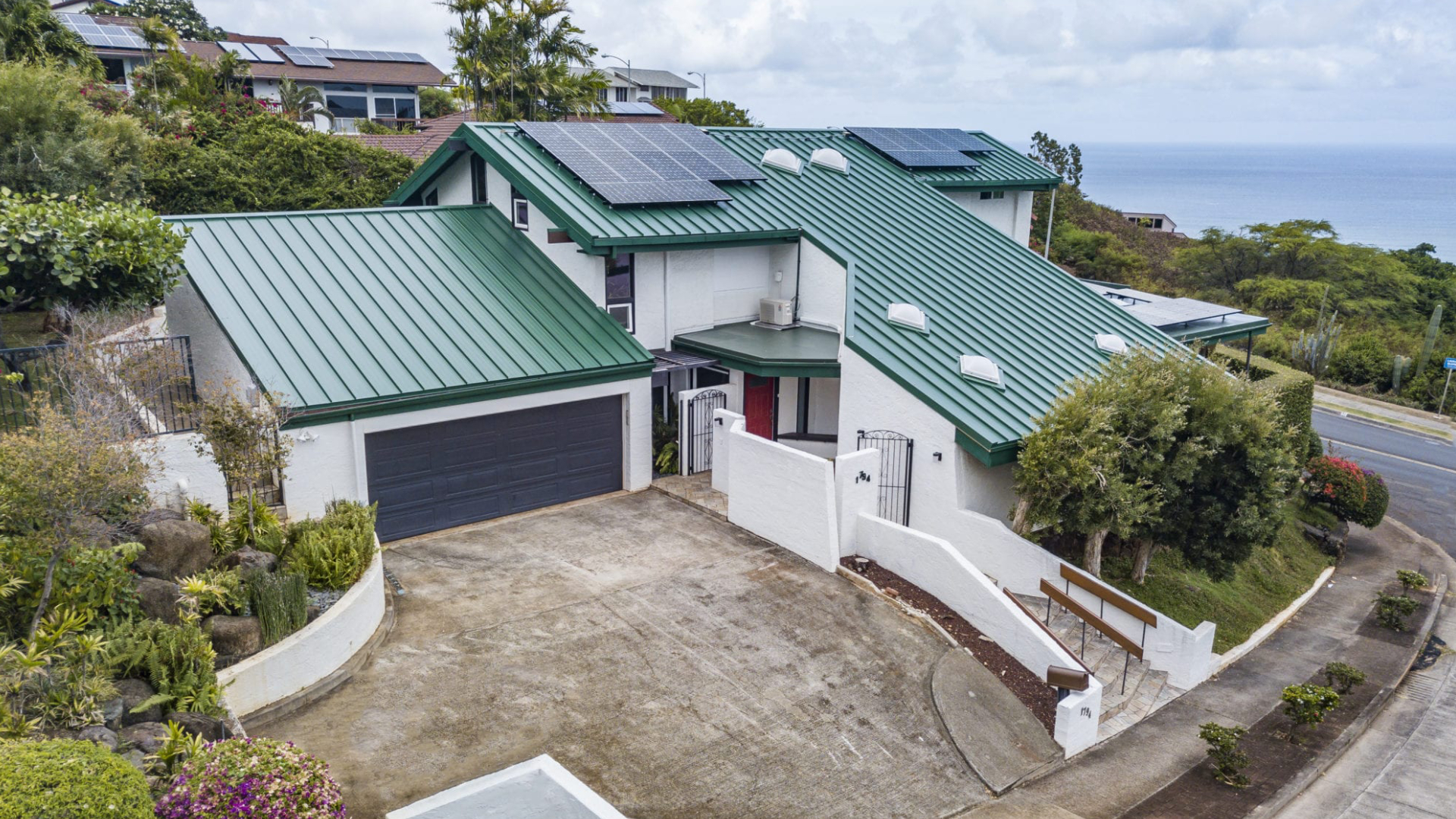Reveal Typical Roof Covering Issues and Just How to Address Them Efficiently
When it comes to your roof, finding troubles early can conserve you time and money. What specific steps should you take to ensure your roof covering continues to be in top problem?
Identifying Roofing System Leaks and Their Reasons

Next, analyze your roofing system from the outside. Try to find missing out on or fractured tiles, rusted flashing, or harmed rain gutters. Take notice of locations around smokeshafts, vents, and skylights, as these are typical leakage sources. If you find any of these concerns, it's essential to resolve them without delay.
During hefty rainfall, observe your roofing system for any type of pooling water or drips. This can expose leakages that could not show up during dry problems. By staying attentive and frequently inspecting your roof, you can catch leakages early and shield your home from further damages.
Handling Missing or Harmed Tiles
When you see missing or harmed shingles, it's important to act promptly to prevent more issues. You'll intend to determine the degree of the damages, repair any type of missing out on roof shingles, and think about preventative maintenance ideas to maintain your roofing in leading form. Taking these steps can save you time and money later on.
Identifying Roof Shingles Damages
Although tiles are created to endure the elements, they can still experience damage over time, leading to prospective leaks and expensive repair services. To identify tile damages, beginning by checking your roofing system for missing out on, split, or crinkled roof shingles. On a regular basis monitoring your roof, particularly after extreme weather condition, can help you capture issues early and keep the integrity of your home.
Fixing Missing Tiles
After identifying roof shingles damage, the following action is resolving any type of missing out on or harmed tiles immediately to prevent additional concerns. If you can, climb onto your roofing system securely, putting on suitable equipment. Taking activity rapidly will aid maintain your roofing system's stability and expand its life-span.
Preventive Maintenance Tips
How can you keep your roofing in top form and stop roof shingles from going missing or obtaining harmed? Inspect your roofing system at the very least two times a year and after extreme climate (roofers oahu).
Keep gutters clean and without debris to assure correct water circulation and avoid tile damage. Trim overhanging branches to decrease the danger of them scraping against your roof covering throughout tornados.
Consider using a protective sealant to prolong your roof shingles' lifespan. If you notice any kind of concerns, address them promptly to avoid expensive repair services later on. Taking these preventive procedures can conserve you time and money while guaranteeing your roofing system continues to be durable and trusted.
Comprehending Roofing Ventilation Issues
Correct roofing ventilation is vital for keeping the long life and effectiveness of your roofing system, as it aids manage temperature and moisture levels in your attic. Without adequate ventilation, you may encounter problems like excessive warm buildup, resulting in early tile damage, or increased humidity that can trigger mold development and timber rot.
To analyze your roofing system air flow, check for signs of overheating, such as warped shingles or a warm attic. Look for obstructed vents, which can limit airflow and catch warm. You should ensure your intake and exhaust vents are balanced, permitting proper air exchange.
If you believe air flow issues, think about mounting added vents or upgrading existing ones. Ridge vents, soffit vents, and gable vents can all enhance airflow. Attending to these concerns promptly can protect your roof covering and conserve you from expensive repair work down the line. Remain positive in preserving your roof covering's air flow to secure your home.
Addressing Roof Moss and Algae Development
While you could value the natural appearance of moss and algae on your roof covering, these organisms can cause substantial issues if left unchecked. They trap moisture, which can cause roof shingles wear and tear and leakages. To tackle this issue, begin by eliminating any visible development. Make use of a soft-bristle brush to gently scrub away the moss and algae, taking care not to damage your tiles.
Next, think about using a specialized roof covering cleaner or a mixture of water and bleach to kill remaining spores. Rinse extensively to avoid any type of chemical damages. Furthermore, set up zinc or copper strips along the ridge of your roof. As rain washes over these metals, it creates a protective obstacle versus future development. Normal inspections and upkeep will assist protect against moss and algae from returning, guaranteeing your roof covering continues to be healthy for years to come.
Fixing Tornado Damage and Wind Problems
After a tornado, it's important to examine your roof for damages created by high winds and hefty rain. Start by examining for missing or damaged tiles, as these prevail casualties. If you see any kind of, it's crucial to replace them without delay to stop leakages. Next, inspect the blinking around chimneys and vents; harmed flashing can lead to water penetration.
Search for any drooping areas, which could show water accumulation or architectural problems. If you locate any debris, like branches or leaves, eliminate them meticulously to stay clear of further damages. If your gutters are obstructed, clear them to guarantee correct drainage.

For small repair services, you could handle it yourself, yet don't be reluctant to call a specialist for considerable damage. Bear in mind, acting rapidly can conserve you from larger troubles down the line, so take that analysis seriously and deal with any type of problems asap.
Identifying Indicators of Architectural Damage
Exactly how can you inform if your roofing system is experiencing from architectural damage? Next off, check for cracks or gaps in the walls or ceiling, as these can indicate shifting or clearing up due to roof concerns. If you observe missing out on or broken tiles, it's important to address them swiftly, as they can expose your roofing to more damage.
Routine Maintenance Tips for Long Life

Regular Inspections Importance
Since a roof covering is your home's initial line of protection versus the components, normal assessments are necessary for keeping its integrity (roofing materials hawaii). You should examine your roofing at the very least two times a year, ideally in spring and loss, to catch potential problems early. Seek missing out on or damaged tiles, indications of leaks, and any debris that might trigger issues. Pay very close attention to areas around chimneys, vents, and blinking, as these are common weak points. If you discover anything unusual, don't hesitate to call a professional for a thorough evaluation. Keeping up with these examinations can protect against expensive repairs down the line and extend your roofing system's lifespan, ensuring your home remains protected for many years to find.
Proper Rain Gutter Upkeep
Regular roof covering assessments normally bring about the importance of proper gutter maintenance. Tidy your seamless gutters at the very least twice a year to avoid obstructions from fallen leaves, dust, and debris. If you live in a tree-heavy area, think about inspecting them extra commonly. Make use of a sturdy ladder and wear gloves while eliminating the accumulation. Check your gutters for leakages or rust; they can create water damage to your roof and home. Make certain downspouts straight water away from your foundation to prevent flooding. Setting up seamless gutter guards can lessen particles build-up and reduce upkeep time. Ultimately, check for proper incline; gutters should incline toward the downspouts to assure ideal water drainage. By following these pointers, you'll extend your seamless gutters' life-span and protect your roof.
Often Asked Questions
Exactly How Can I Pick the Right Roof Product for My Home?
To select the right roof covering material for your home, take into consideration climate, durability, and visual appeals. Study alternatives like asphalt shingles, metal, or ceramic tile. Think of upkeep requirements and budget to discover what matches you ideal.
What Are the Indicators I Need a Roofing System Substitute Rather of Repair?
If you observe extensive leakages, sagging, or missing out on shingles, you might need a roof covering substitute. If your roofing companies honolulu roof's nearing its life-span or has substantial damages, it's time to consider a full replacement instead of just repair work.
Exactly how Often Should I Schedule Expert Roofing Examinations?
You need to arrange specialist roofing examinations a minimum of annually, ideally in spring or fall. This helps capture potential concerns early, ensuring your roofing system stays in great condition and extending its life expectancy.
Can I Set Up a New Roofing System Over My Old One?
You can install a brand-new roof covering over your old one, yet it's crucial to examine neighborhood structure codes and assure the existing roof's problem is audio. This approach can conserve time and cash, however think about prospective difficulties.
What Is the Ordinary Life-span of Various Roofing Materials?
The standard life-span differs by product: asphalt shingles last 15-30 years, steel roof coverings can last 40-70 years, while ceramic tile or slate roofing systems may exceed half a century. Select wisely based on your environment and budget plan.
Conclusion
By remaining cautious and attending to usual roof covering issues promptly, you can shield your home and prolong your roof's lifespan. Frequently inspect for leakages, damaged tiles, and ventilation issues, and take on moss or algae development before it aggravates - roofing companies honolulu. After storms, check for any damages and make necessary fixings. With a little routine upkeep, you'll not just secure your investment yet also appreciate satisfaction understanding your roof is in leading shape. Don't wait-- act currently!
 Jaleel White Then & Now!
Jaleel White Then & Now! Charlie Korsmo Then & Now!
Charlie Korsmo Then & Now! Melissa Joan Hart Then & Now!
Melissa Joan Hart Then & Now! Bo Derek Then & Now!
Bo Derek Then & Now! Robin McGraw Then & Now!
Robin McGraw Then & Now!